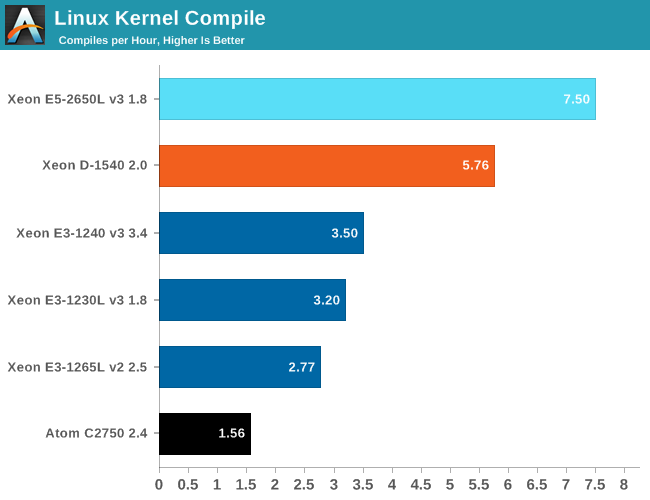The Intel Xeon D Review: Performance Per Watt Server SoC Champion?
by Johan De Gelas on June 23, 2015 8:35 AM EST- Posted in
- CPUs
- Intel
- Xeon-D
- Broadwell-DE
Compiling with gcc
A more real world benchmark to test the integer processing power of our Xeon servers is a Linux kernel compile. Although few people compile their own kernel, compiling other software on servers is a common task and this will give us a good idea of how the CPUs handle a complex build.
To do this we have downloaded the 3.11 kernel from kernel.org. We then compiled the kernel with the "time make -jx" command, where x is the maximum number of threads that the platform is capable of using. To make the graph more readable, the number of seconds in wall time was converted into the number of builds per hour.
The Xeon D delivers at least 65% better performance than the Xeon E3s. Considering the low TDP, that is pretty amazing. The Xeon E5 delivers 30% more with 50% more cores - as the Xeon E5 is twice as expensive, the Xeon D holds a massive performance per dollar advantage. The brawny Broadwell cores of the Xeon D compile no less than 3.7 times faster than the small Silvermont cores of the Atom, meaning that compiling definitely favors the more sophisticated cores.
If you regularly compile large projects, the Xeon D is one of the best choices you have - even compared to a highly clocked Core i7 solutions. The cheaper quad core i7s will perform like the Xeon E3-1240, the equally priced ($583) i7-5930k will do about 50% better, still below the Xeon D. The Xeon D offers you integrated dual 10 Gb Ethernet, SATA, USB, which should offer lower latency. The Xeon D can also support twice as much memory (128 GB vs 64 GB) and offer you a much lower power bill (45W vs 140W TDP), making hardware decisions around compilation based projects an easy choice to make.











90 Comments
View All Comments
zodiacfml - Tuesday, June 23, 2015 - link
this is the reason why Intel focuses on mobile, it benefits their server cpus too.the 14nm process is the one to thank for these massive improvements. Samsung also has 14nm and the S6 Exynos is in similar achievement
Refuge - Tuesday, June 23, 2015 - link
I disagree, the Exynos is no where close to a similar achievement.Granted it is doing better than Qualcomm's equivalent at the moment.
But I'm also faster than a fat man with a broken leg running on a hot and humid day.
zodiacfml - Tuesday, June 23, 2015 - link
Still, these 14nm SoCs are the best in their class as they pack more cores while using less power.LukaP - Thursday, June 25, 2015 - link
Just a note, Samsung's (and TSMC's 16nm FF(+) process isnt really 16nm entirely. The interconnects are still 28nm making it not nearly as dense as intel's 14nm, as well as being more leaky. IIRC their density and leakage can be compared to intels 22nm TriGate in the times of Ivy Bridgenils_ - Tuesday, June 23, 2015 - link
Few questions:1. Why did you disable x2apic?
2. Did the Large Page allocation in the Java Benchmark actually work? It can be a bit tricky some times and then falls back to 4KiB pages
3. What were the JVM settings for elasticsearch?
JohanAnandtech - Thursday, June 25, 2015 - link
1. Was out of the box disabled. I have to admit I did not check that option. Performance impact should be neglible though.2. I have no monitored that, but there was a performance impact if we disabled it.
3. ES_heap_size = 20 G; otherwise standard ES settings
Daniel Egger - Tuesday, June 23, 2015 - link
Wow, that is still quite pricey here. For the price of the SuperMicro tower you can actually get a 1U 2S Xeon E5 system with one socket equipped and some memory. I'd really love to replace my home server (running on Core i5 rather than Xeon E3 for efficiency reasons, those C chipset suck balls) with one of those systems if they can make them efficient and quiet.hifiaudio2 - Tuesday, June 23, 2015 - link
Two questions:1. How does the Xeon D compare to the c2700 series for a home NAS that will also serve as an Emby server and HDHR DVR (when that software is available). Could be one or two 1080p transcodes going on at the same time at most. Usually no transcoding if I am using Kodi or something that can natively play back the file, but for remote viewing or random uses over the network, some transcoding by Emby could be required -- if you are not familiar with Emby think of the same thing using Plex. So would the extra power of the Xeon D be of use to me, or is the 8 core c2750 plenty for the aforementioned use case?
2. If I do go with this unit, which dimms specifically does it use? The Supermicro c2750 board takes laptop style dimms. What does this take?
JohanAnandtech - Tuesday, June 23, 2015 - link
I can answer 2: see the picture here: http://www.anandtech.com/show/9185/intel-xeon-d-re... RDIMMs or UDIMMS (= basically "normal" DDR-4) will do.hifiaudio2 - Tuesday, June 23, 2015 - link
Thanks.. So this ram:?http://www.amazon.com/Crucial-PC4-2133-Registered-...
And what is the SR x4 / DR x8 difference in the two choices for the 8gb sticks?